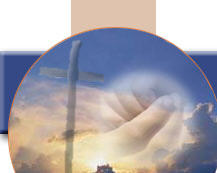



|
|
Overview |
|

![]()
The Journey Celebrated
and Nourished
"On this mountain
the Lord of hosts will make for all people
a feast of rich food,
a feast of well-aged wines."
Isaiah.
Meals, especially celebratory ones, are an important part of life. Conversations, stories and speeches over festive tables are core to our celebration of life with one another. A young couple celebrate their love with an intimate meal. Family members come together for their Christmas feast. A party group celebrates a birthday. Mourners gather at the ‘wake’ of a friend. Guests revel in the love of their newly married friends. Good friends gather to enjoy one another company.
This human experience of meals, a gathering for word and meal, resonates with Eucharistic meaning. There is a rich tapestry of symbolism that comes to us from many sources about this Christian sacred meal. We will explore a few of these sources.
The symbolism of Jewish celebration meals is very special to Christians. To the Jew every meal was sacred. It mattered very much with whom you ate and drank.
The banquet of the Messiah, (Hebrew for the Anointed One, Christos in Greek), given in Isaiah's prophecy (Is. 25) is a high point in this Jewish symbolism and speaks wonderfully of celebration. It gives a vision of what life could be if lived with, and nourished by, the Anointed One. This is the banquet of a new age.
There were three meals from Jewish heritage that give meaning to the Christian celebration of the Eucharist.
Foremost is the Passover meal (Exodus 12). It was a meal of the Lamb, the bread and other symbols of the Jewish people's time of slavery in Egypt. This meal and its story made present the time when they were led out of that slavery, through the waters of the Red Sea, to the teaching of the Sinai where the commandments of God were given. It remembered their purifying journey in the desert where God nourished them with the manna from heaven and the water from the Rock. It recalled their entry into the Promised Land. God's Spirit led them in this journey and was present with them in the Tabernacle, the Tent of Meeting. This powerful story has many associations with what Jesus said and did in the Last Supper and on Calvary.
The Jewish people also had the Habburah meal which was a meal of teaching between a Rabbi (Teacher) and his disciples. These were fellowship meals in which the Rabbi instructed his disciples. In Jewish thought this idea of Habburah meal was to be completed with the banquet with the Messiah, (cf. Is 15). Jesus often taught in the context of meals, especially in Luke's Gospel.
Yet another type of meal was the Todah meal which was a meal in the Temple. It consisted of a prayer of thanksgiving for some benefit, (the safe birth of my child, the gift of a good crop), and the offering of sacrifice, (e.g. a sack of wheat, a lamb), part of which was thrown on the altar of sacrifice in the Temple, part of which was shared with those gathered (especially the poor). This was a prayer of thanks and sacrifice with a communion with God and among the people.
All these rich images influence the meaning, the symbolism of the Eucharist:
- the Passover with its salvation and journey themes,
- the Habburah with its teaching fellowship, fulfilled with the Messianic banquet,
- the Todah with its thanksgiving for benefits and sacrifice/communion with God and one another.
So in the Eucharist we celebrate
- with praise, the saving story of Jesus who, like Moses, leads us out of the slavery of sin;
- the Lamb of God whose blood is poured out for our deliverance;
- the God who is with us on the journey, nourishing us with food and drink; - the Teacher who guides our way and who leads us to the promised land of the eternal banquet;
- our fellowship with one another in the bread broken.
- our communion sacrifice - a communion with one another and with our God whom we thank for so many benefits in life.
Another group of symbols, that build upon the Jewish meal images, come from the accounts of the Last Supper of Jesus. There are five written accounts. They are found in the four Gospels (Mk 14:22-24;
Mt 26:26-28; Lk 22: 19-20; Jn 6:51 and 13) and in Paul's First Letter to the Corinthians (1 Cor 11:24-25).
These accounts, with their varying perspectives and contexts, give us further understanding of the many meanings of the Eucharist. Mark and Matthew, Paul and Luke provide us with the account of the meal itself, the bread and wine, the words and actions of Jesus. Mark and Matthew emphasise the meaning of Eucharist as sacrifice, the wine poured out for the forgiveness of sin. Paul and Luke emphasise the fellowship perspective, the breaking of bread.
John does not give us a direct account of the taking of bread and wine. Rather he gives us a perspective on how Jesus wants to be remembered. It is like his last will and ‘new’ testament. Disciples are to live in memory of Jesus in the symbols of service, (the washing of the feet in Jn 13) and of love (the love command in Jn 17).
Luke really brings these two traditions together (Lk 22: 14-27) with their metaphors of sacrifice, fellowship, service and love. We need, today, to put these two traditions together in our celebrations. It is putting together ‘going to church’ and practical, day-to-day, love and service.
Schema
The LAST SUPPER has two Traditions
Sacramental ritual: New Testament
Two forms of meaning in meaning is in
Service
Matthew/Mark Paul/Luke and the
= sacrifice = fellowship love command
These traditions come together in Luke’s Gospel (Lk 22:24-27)
EUCHARISTIC CELEBRATION =
Sacramental Memorial Fulfillment of the love
Of Sacrifice and Table Friendship command in daily life
There is a marriage between the daily living of the ‘testament’ of love and service and the ritual that reminds us about such living.
There is some divorce of these two elements today
More meaning comes from the structure of the celebration. There is a movement
- from gathering in faith,
- to listening and responding to the Word of God,
- to being nourished in the Spirit as the Body of Christ,
- to being sent on mission as a community for the world.
If the Eucharist and liturgy are about ‘full, conscious and active participation’ (Vatican 11: Constitution on the Sacred Liturgy[CSL] no. 14) then such meaning calls us to faith, to proclamation of the Word, to communion with Jesus and one another, and challenges us to be people of his mission today.
Yet another set of meanings come from the traditional doctrines of the Roman Church of Real Presence, Sacrifice and Memorial.
The Real Presence of Jesus is celebrated:
· in the gathered community of faith
· in the celebrant
· in the Word of God and, above all,
· int eh blessed Eucharist.
The Risen Lord is present in the midst his faithful. Such reality gives us enormous hope in the transforming power of the Risen Lord amongst us as we take up his mission of transformation.
Through the doctrine of sacrifice we know of the one self offering of Jesus, now risen, truly present. Jesus who offered himself on the Cross is truly and sacramentally present. This doctrine draws us to a communion with Christ's self-offering, surely a great challenge for us in today's troubled world.
These doctrines of Real Presence and Sacrifice associate with the memorial command ‘do this in memory of me’. In the Hebrew understanding keeping memorial, as well as calling to mind the event, makes it present. In the Eucharist, the event of the Last Supper, in all its power and meaning, is present and celebrated.
We could go on, and indeed, people in our time are going on, exploring the fullness of the symbolism, tradition and history of this sacrament. There is a wonderful diversity of meaning in the Eucharist that has been used by Christians to celebrate their world of love and work, life and death, struggle and prayer at the heart of the life of faith.
Eucharist, like all symbolism, is inexhaustible in its meaning. It is in the respect for the diversity of this symbolism that relevance and harmony will emerge.
As we know, the celebration of the Eucharist, while it is the core celebration of Christians, is also a source of scandal. What Jesus wanted as a sign of unity and harmony is a sign of division.
One of the tensions of theology has been a conflict of interpretations between groups of Christians about the Eucharist. Happily, these days, we are looking at the possibility of the unity between diverse doctrinal and ritual interpretations.
This does not mean turning our backs on the conflict of interpretations, but it does mean looking at all the tensions in context from their scriptural origins through to the difficulties at the time of the Reformation in the sixteenth century. It does mean rediscovering the language of symbol and human sciences and art that form ritual celebrations. It does mean appreciating and respecting the contributions of Orthodox, Reformation and Catholic positions. It does mean being conscious of culture so that there is a relevance in the celebration of the Eucharist. It does mean living with the fact, already expressed, that Eucharistic symbolism is inexhaustible in its meaning. Eucharist is not limited to one exclusive meaning.
In our times there is a convergence of Christian theology and celebration that is seeking to express a more complete picture of the Last supper's command ‘do this in memory of me’. There is more respect for the meaning that arises from complimentary traditions. In dialogues between Christian churches there is growing agreement and understanding about diverse opinions so that there is hope for eucharistic unity.
As well as these theological and ecumenical considerations there is the tension of relevance of the Eucharist to society and our world. There are many criticisms about it being ‘boring’, about it being attended by ‘hypocrites - Sunday Christians’. There is apathy, a ‘so what’ attitude.
Its form and style, its music and gesture, are seen as antiquated. It is seen as a museum piece rather than an expression of our need for meaning. Ethnic groups around the world see it as structured on European lines and symbolism that does not take their cultural realities into consideration.
It is no good being defensive about many of these perceptions. Owning some truth in them is the very reason for the renewal. Work is being done to make new forms, new styles of celebration that speak the language of the people.
Such shifts began with the change from Latin to modern languages in the Roman Catholic Church in the sixties, and many other ecumenical and cultural initiatives.
These initiatives own that the celebration is not just ‘worship for worship's sake’, a liturgical concert of nostalgic past glories. It is seeking to be the ‘source’ and ‘summit’ (Vatican 11, Constitution on the Sacred Liturgy, no. 10) of our lives that uses the rich artistic tradition and tapestry of symbolism in a culturally relevant way. This is complex in our multicultural, pluralistic societies.
Again, the liturgy today seeks to move us from being ‘Sunday Christians’. The very point of the ritual is to bring to mind, to ‘re-member’, who we are as baptised people confirmed in the Spirit. We are in communion with the Christos, the Anointed One, in whom a new age is being created.
The attempts to make liturgy both reflect and address our everyday life is critical. Gospel life and spirit, celebrated in the Eucharist, permeates every aspect of our relationships with one another and our earth. It speaks into the real issues of life, our needs, our quest for justice, love and peace.
At the same time as all this is happening it needs to be said that apathy and cynicism about the meaning of the Eucharist are not creative responses. The Spirit seeks openness and challenges us all to use our gifts of intelligence to discover in this wealth of theology and in the action of eucharistic celebrations the God present and active. God, in Jesus, is breaking into our world and lives. The offer is made. Responses like openness to prayer and sacramental action can will deepen our appreciation of God.
We are at a new moment of grace in our renewal of Eucharistic life. We have explored some of the wealth and abundance of its history and tradition. As the Spirit directs us to reflect on this rich heritage, people of each culture will be led to ‘do this in memory of me’ with relevance and with grace, in unity and harmony with each other and our world.
Further Reading:
Hellwig, Monika. "Eucharist and Hunger for the World".
Paulist Press, New York 1978.
A study of the main issues around Eucharist today.
|
|
|
|


Copyright © Anthony Kain 2009